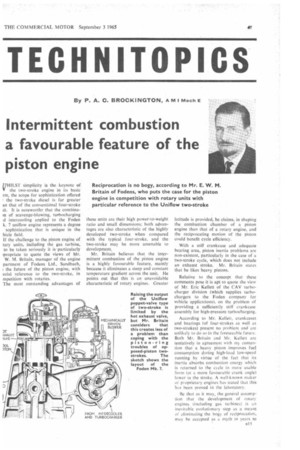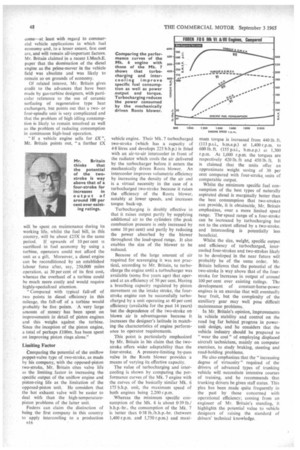Intermittent combustion a favourable feature of the piston engine
Page 49

Page 50

If you've noticed an error in this article please click here to report it so we can fix it.
Reciprocation is no bogy, according to Mr. E. W. M. Britain of Fodens, who puts the case for the piston engine in competition with rotary units with particular reference to the Uniflow two-stroke UHILST simplicity is the keynote of V the two-stroke engine in its basic rm, the scope for sophistication offered the two-stroke diesel is far greater an that of the conventiOnal four-stroke lit. It is noteworthy that the combinam of scavenge-blowing, turbocharging id intercooling applied to the Foden k. 7 unillow engine represents a degree sophistication that is unique in the hide field.
If the challenge to the piston engine of tary units, including the gas turbine, to be taken seriously it is'particularly propriate to quote the views of Mr. W. M. Britain, manager of the engine partment of Fodens Ltd., Sandbach, the future of the piston engine, with ccial reference to the two-stroke, in mpetition with rotaries.
The most outstanding advantages of
these units are their high power-to-weight ratio and small dimensions; both advantages are also characteristic of the highly developed two-stroke when compared with the typical four-stroke, and the two-stroke may be more amenable to development.
Mr. Britain believes that the intermittent combustion of the piston engine is a highly favourable feature, mainly because it eliminates a steep and constant temperature gradient across the unit. He points out that this is an unavoidable characteristic of rotary engines. Greater
latitude is provided, he claims, in shaping the combustion chamber of a piston engine than that of a rotary engine, and the reciprocating motion of the piston could benefit cycle efficiency.
With a stiff crankcase and adequate bearing area, piston inertia problems are non-existent, particularly in the case of a two-stroke cycle, which does not include an exhaust stroke. Mr. Britain states that he likes heavy pistons.
Relative to the concept that these comments pose it is apt to quote the view of Mr. Eric Kellett of the CAV turbocharger division (which supplies turbochargers to the Foden company for vehicle applications), on the problem of providing a sufficiently stiff crankcase assembly for high-pressure turbocharging.
According to Mr. Kellett, crankcases and bearings (of four-strokes as well as two-strokes) present no problem and are unlikely to do so in the foreseeable future. Both Mr. Britain and .vii. Kellett are tentatively in agreement with m), contention that a heavy piston improves fuel consumption during high-load low-speed running by virtue of the fact that its inertia absorbs combustion enemy which is returned to the c.cle in more usable form (at a more favourable crank angle) lower in the stroke. A well-known maker of proprietary engines has slated that this has been proved in the laboratory.
Be that as it may, the general assumption that the development of rotary engines (including gas turbines; is an inevitable evolutionary step as a means o eliminating the bogy of reciprocation, may be accepted as a myth in years to eome—at least with regard to commercial vehicle applications in which fuel economy and, to a lesser extent, first cost are, and will remain all-important factors. Mr. Britain claimed in a recent I.Mech.E. paper that the domination of the diesel engine as the prime-mover in the vehicle field was absolute and was likely to remain so on grounds of economy.
Of related interest. Mr. Britain gives credit to the advances that have been made by gas-turbine designers, with particular reference to the use of ceramic surfacing of regenerative type heat exchangers. but points out that a twoor four-spindle unit is very complicated and that the problem of high idling consumption is likely to remain unsolved as well as the problem of reducing consumption in continuous high-load operation.
"If a vehicle engine sells for LX", Mr. Britain points out, "a further EX
will be spent on maintenance during its working life, whilst the fuel bill, in this country, will be about f25X in the same period. If upwards of 10 per cent is sacrificed in fuel economy by using a turbine, operators could not afford the unit as a gift. Moreover, a diesel engine can be reconditioned by an established labour force after, say, 250,000 miles operation, at 30 per cent of its first cost, whereas the overhaul of a turbine could be much more costly and would require highly-specialized attention.
Compared with typical fall-off of two points in diesel efficiency in this mileage, the fall-off of a turbine would probably be five points. A very large amount of money has been spent on improvements in detail of piston engines and this weighs against the turbine. Since the inception of the piston engine, a total of perhaps f100m. has been spent on improving piston rings alone."
Limiting Factor Comparing the potential of the uniflow poppet-valve type of two-stroke, as made by his company, with the opposed-piston two-stroke, Mr. Britain cites valve life as the limiting factor in increasing the specific output of the uniflow engine and piston-ring life as the limitation of the opposed-piston unit. He considers that the hot exhaust valve will be easier to deal with than the high-temperaturepiston problems of the latter unit.
Fodens can claim the distinction of being the first company in this country to apply intercooling to a production n16
vehicle engine. Their Mk. 7 turbocharged two-stroke (which has a capacity of 4-8 litres and develops 225 b.h.p.) is fitted with an air-to-air intercooler in front of the radiator which cools the air delivered by the turbocharger before it enters the mechanically driven Roots blower. An intercooler improves volumetric efficiency by increasing the density of the air and is a virtual necessity in the case of a turbocharged two-stroke because it raises the efficiency of the Roots blower, notably at lower speeds, and increases torque back-up.
Turbocharging is doubly effective in that it raises output partly by supplying additional air to the cylinders (the peak combustion pressure is only increased by some 10 per cent) and partly by reducing the power absorbed by the blower throughout the load-speed range. It also enables the size of the blower to be reduced.
Because of the large amount of air required for scavenging it was not practical, according to Mr. Britain, to turbocharge the engine until a turbocharger was available (some five years ago) that operated at an efficiency of 50 per cent. Having a breathing capacity regulated by piston movement on the intake stroke, the fourstroke engine can be successfully turbocharged by a unit operating at 40 per cent efficiency (available for the past 14 years) but the dependence of the two-stroke on blown air is advantageous because it increases the designer's latitude in matching the characteristics of engine performance to operator requirements.
This point is particularly emphasized by Mr. Britain in his claim that the twostroke offers wider adaptability than the four-stroke. A pressure-limiting by-pass valve in the Roots blower provides a means of varying its effective capacity.
The value of turbocharging and intercooling is shown by comparing the performance curves of the Mk. 7 engine with the curves of the basically similar Mk. 6 175 b.h.p. unit, the maximum speed of both engines being 2,200 r.p.m.
Whereas the minimum specific consumption of the Mk. 6 is about 0-39 lb./ b.h.p.-hr., the consumption of the Mk. 7 is better than 0-38 lb./b.h.p.-hr. (between 1,400 r.p.m. and 1,750 r.p.m.) and maxi
mum torque is increased from 440 lb. ft. (113 p.s.i., b.m.e.p.) at 1,400 r.p.m. to 600 lb. ft. (155 p.s.i., b.m.e.p.) at 1,300 r.p.m. At 1,000 r.p.m. the torques are respectively 420 lb. ft and 450 lb. ft. It is claimed that the units offer an approximate weight saving of 30 per cent compared with four-stroke, units of comparable output.
Whilst the minimum specific fuel consumption of the best types of naturally aspirated diesel is marginally better than the best consumption that two-strokes can provide, it is obtainable, Mr. Britain emphasizes, over a more limited speed range. The speed range of a four-stroke can be increased by turbocharging but not to the extent offered by a two-stroke, and intercooling is potentially less beneficial.
Whilst the size, weight, specific output and efficiency of turbocharged, intercooled four-strokes and two-strokes likely to be developed in the near future will probably be of the same order. Mr. Britain believes that the potential of the two-stroke is way above that of the fourstroke for increases in output of around 100 per cent over existing ratings. The development of constant-horse-power engines is an exercise that will eventually bear fruit, but the complexity of the auxiliary gear may well pose difficult maintenance problems.
In Mr. Britain's opinion, improvements in vehicle stability and control on the road lag far behind progress in powerunit design, and he considers that the vehicle industry should be prepared to "wear the cost" of employing displaced aircraft technicians, mainly on computer exercises, to study braking, steering and road-holding problems.
He also emphasizes that the "increasing degree of virtuosity" required of the drivers of advanced types of trunking vehicle will necessitate intensive courses of training, and he recommends that trunking drivers be given staff status. This plea has been made quite frequently in the past by those concerned with operational efficiency; coming from an engineer of Mr. Britain's standing, it highlights the potential value to vehicle designers of raising the standard of drivers' technical knowledge.




























































































































































